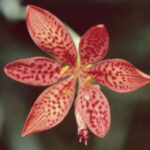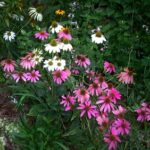If you want a beautiful, hardy, and easy to grow, geraniums are a great choice. They are incredibly versatile; geraniums are great flowers for containers, window boxes, or in an outside garden. Geraniums are generally easy to care for, making them the perfect plant for any gardener, from beginner to pro.
Shared Characteristics of Geraniums
Geraniums require full sun in a cool climate, and partial shade in a cool climate. However, geraniums require four hours of direct sunlight per day no matter what type of climate exists. Be sure the soil is fertile and well drained, and allow the soil to partially dry in between watering times.
Garden Geraniums should be fertilized every two weeks using a half strength standard fertilizer. Wait two weeks after transplanting geraniums into the ground before fertilizing.
Container geraniums require a little more care; they need a full strength fertilizer added to their water every two weeks. A fertilizer with an NPK of 5-10-5 is perfect.
Even though geraniums are annuals, it is possible to save them for next year. Simply transplant the geranium from the ground into a pot prior to the first frost and bring them inside for the winter. In the spring, transplant it back to the ground & cut the stems down approximately by half. This will stimulate lush growth.
Geraniums grow well in zones two through nine on the USDA Plant Hardiness Map of North America. This area covers from Northern Canada down to south Texas and the middle of Florida.
Propagation
Geraniums are easy to propagate. Cut off shoots between three to five inches long and remove all leaves on the lower part of the stem. Dip the end of the stem in a rooting hormone solution; liquid or gel forms work best. Plant the cutting approximately an inch deep in a sterile potting soil solution. Keep the soil moist but not overly wet; if the soil is still wet, wait a couple days before watering. Place in a bright spot with indirect sunlight, and the geranium is almost guaranteed to grow.
Geranium Pests and Diseases
Geraniums are generally easy to care for. However, like all plants, geraniums do have some problems that may arise. These include bacterial leaf spots, pythium, spider mites and gray mold.
Bacterial leaf spots are an indication of too much humidity, too much water, or over-crowded leaves. They manifest with brown or black spots on the leaves. Remove infected leaves immediately upon discovery & increase the air circulation. If indoors, a fan will work perfectly. Increasing air circulation outside can be a little tricky, but try to make sure the leaves on your geraniums are not too crowded, and air can easily get around all parts of the plant.
Pythium is associated with root rot and is introduced by an overabundance of moisture. Pythium is easier to prevent than it is to cure. To prevent pythium infections, allow a geranium’s soil to dry between watering cycles, and do not overcrowd the plants. Chemical sprays such as Subdue Maxx, Banrot and Heritage are effective to control the spread of Pythium infections.
Spider mites are common garden pests. They are easily controlled by spraying them off plants with a steady stream of water, or attracting natural enemies of the spider mites. Ladybugs will be able to deal with mild infestations. For extreme spider mite infestations, insecticides may be used.
Botrytis blight, most commonly known as gray mold, is a fungal disease that is most likely to show up in cool, moist conditions. To prevent gray mold, ensure air can circulate around the geraniums leaves and flowers, and allow the soil to dry between watering cycles. Remove leaves, stems and blooms with gray mold on them to prevent the spread of gray mold.
Some of the more popular breeds of geraniums are described below. The details listed are additions to the generic characteristics of geraniums.
Scented Geraniums
Pelargonium Species
The scented geraniums are an interesting breed. They only generate tiny flowers in comparison to other geraniums, but their leaves are scented. Rub the leaves of this geranium and scents like oranges, roses, mints, lemons or coconut are released into the air.
There are over fifty different types of scented geraniums. Some of them have trailing stems, making them perfect for hanging baskets or window boxes. Others can grow up to a foot to a foot and a half tall in containers.
Pests and diseases that like the scented geranium include the geranium bud worm, aphids, rust and bacterial wilt. Rust and bacterial wilt can both be avoided by keeping the soil moist, but not soaked. Too much wetness will cause geraniums to have many problems, some of which can lead to their demise.
The geranium bud worm is a hard pest to get rid of. If you have an infestation, the best way to control it is to use synthetic pyrethrins, also called pyrethoid insecticides. Aphids can be killed off by insecticides or spraying them with a stream of water.
Martha Washington Geraniums
Pelargonium X Domesticum
The Martha Washington geraniums have beautiful clusters of two-inch wide flowers. They come in a range of beautiful colors: white, pink, red, lavender or purple, with a darker shade on the upper petals.
This geranium has heart or kidney shaped leaves that are between two and four inches wide. It grows to be between twelve and eighteen inches tall, and is a bushy plant, so plant them at least two feet apart.
To extend the Martha Washington geranium’s growing season, cut dead flowers off. Promote branching of the stems by pinching the growing buds.
Zonal Geraniums
Pelargonium X Hortorum
The zonal geranium is a sturdy plant, with hairy, round leaves that are often marked with green or brown bands. The stems are thin but sturdy, and two-inch wide flowers grow in a ball at the tips. The flowers can be white, red, pink, lavender, orange, peach or variegated.
This is a great geranium for attracting hummingbirds and to place in a cutting garden. They should be planted twelve to eighteen inches apart, and grow between a foot and two feet tall.
Ivy Geraniums
Pelargonium Peltatum
Because of their trailing stems, the ivy geraniums are perfect for hanging baskets. Its leaves are glossy and green, and resemble ivy leaves; hence, its name. The flowers are available in red, pink, burgundy, lavender and white. Like the zonal geraniums, the ivy geraniums attract hummingbirds.







